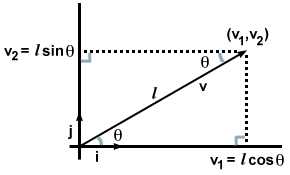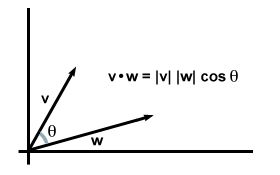Technically speaking, the dot product is a kind of scalar product. This means that it is an operation that takes two vectors, "multiplies" them together, and produces a scalar. We don't, however, want the dot product of two vectors to produce just any scalar. It would be nice if the product could provide meaningful information about vectors in terms of scalars.
What do we mean by "meaningful"? Glad you asked. To begin, let's look for scalar quantities that can characterize a vector. One easy example of this is the length, or magnitude, of a vector v, usually denoted by | v|. Every one of the 2- and 3-dimensional vectors that we have been discussing has length, and length is a scalar quantity. For instance, to find the length of a vector (a, b, c), we just need to compute the distance between the origin and the point (a, b, c). (The idea is the same in two dimensions). Our measurement will yield a scalar value of magnitude without direction--not another vector! This type of scalara sounds like the kind of meaningful information the dot product could provide for us.
Component Method
The Pythagorean Theorem tells us that the length of a vector (a, b, c) is
given by  . This gives us a clue as to how we can define the
dot product. For instance, if we want the dot product of a vector
v = (v1, v2, v3) with itself (v·v) to give us information about the length of
v, it makes sense to demand that it look like:
. This gives us a clue as to how we can define the
dot product. For instance, if we want the dot product of a vector
v = (v1, v2, v3) with itself (v·v) to give us information about the length of
v, it makes sense to demand that it look like:
| v·v = v1v1 + v2v2 + v3v3 |
Hence, the dot product of a vector with itself gives the vector's magnitude squared.
Ok, that's what we wanted, but now a new question reigns: what is the dot product between two different vectors? The important thing to remember is that whatever we define the general rule to be, it must reduce to whenever we plug in two identical vectors. In fact, @@Equation @@ has already been written suggestively to indicate that the general rule for the dot product between two vectors u = (u1, u2, u3) and v = (v1, v2, v3) might be:
| u·v = u1v1 + u2v2 + u3v3 |
This equation is exactly the right formula for the dot product of two 3-dimensional vectors. (Note that the quantity obtained on the right is a scalar, even though we can no longer say it represents the length of either vector.) For 2-dimensional vectors, u = (u1, u2) and v = (v1, v2), we have:
| u·v = u1v1 + u2v2 |
Again, by plugging in u = v, we recover the square of the length of the vector in two dimensions.
Geometric Method
So what does the scalar obtained in doing the dot product u.v represent? We can get an idea of what's going on by looking at the dot product of a vector with unit vectors. In Unit Vectors we defined the unit vectors i, j, and k for the 3-dimensional case. In two dimensions we have only i = (1, 0) and j = (0, 1). (For now we will work in two dimensions, since it is easier to represent such vectors graphically.) The dot products of a vector v = (v1, v2) with unit vectors i and j are given by:
| v·i | = | v11 + v20 = v1 | |
| v·j | = | v10 + v21 = v2 |
In other words, the dot product of v with i picks off the component of v in the x-direction, and similarly v's dot product with j picks off the component of v which lies in the y-direction. This is the same as computing the magnitude of the projection of v onto the x- and y-axes, respectively.
This may not seem too exciting, since in some sense we already knew this as soon as we wrote our vector down in terms of components. But what would happen if instead of components we were given only the direction and magnitude of a vector v, as in the following picture?

In this case, by noticing the two right triangles formed and recalling rules from trigonometry, we find that v·i and v·j can be computed in a different way. Namely:
| v·i | = | | v| cosθ | |
| v·j | = | | v| sinθ = l cos(90 - θ) |
What happens if we take the dot product of v with a generic vector which lies purely in the x-direction (i.e. not necessarily a unit vector)? We can write such a vector as w = (w1, 0) = w1(1, 0) = w1i, and it is clear that the magnitude of w is | w| = w1. Hence, w = | w|i. Using the above rule for the dot product between v and i, we find that:
| v·w = | v|| w| cosθ |
In fact, this equation holds in general: if we take v and w to be arbitrary vectors in either two or three dimensions, and let θ be the angle between them, we find that this version of the dot product formula agrees exactly with the component formula we found previously.

Notice that when the vectors lie in the same direction, θ = 0 and cosθ attains its maximum value of 1. (In particular, this is the case then the two vectors are the same, recovering our initial requirement for the dot product: v·v = | v|2.) In fact, for vectors of equal magnitude, the smaller the angle is between them the larger their dot product will be. It is in this sense that we can say that the dot product yields information about how much two vectors "overlap." For instance, when two vectors are perpendicular to each other (i.e. they don't "overlap" at all), the angle between them is 90 degrees. Since cos 90o = 0, their dot product vanishes.
Summary of Dot Product Rules
In summary, the rules for the dot products of 2- and 3-dimensional vectors in terms of components are:
| u·v = u1v1 + u2v2 |
| u·v = u1v1 + u2v2 + u3v3 |
The rule for vectors given in terms of magnitude and direction (in either 2 or 3 dimensions), where θ denotes the angle between them, is:
| v·w = | v|| w| cosθ |













